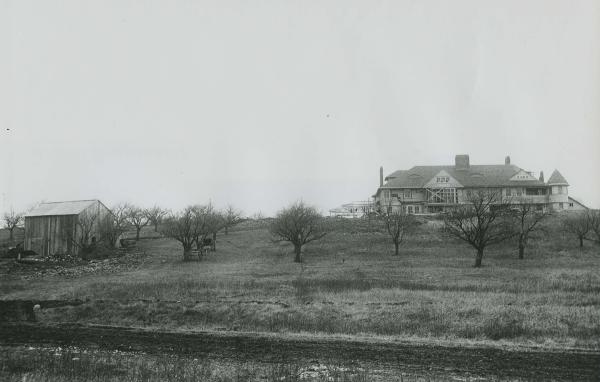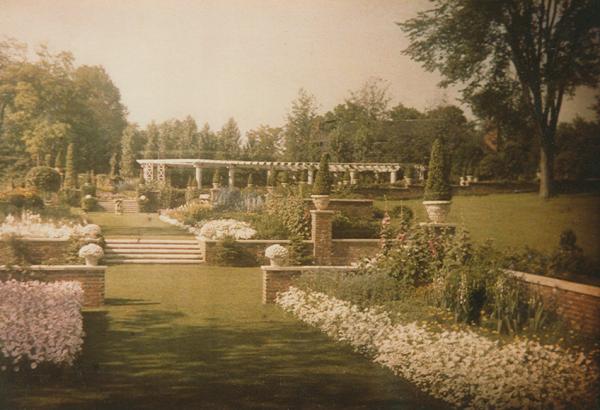A History of the Formal Gardens
-- Lila Osgood Webb, July 23, 1926
Lila Osgood Webb placed an announcement in the Burlington Free Press inviting visitors to come and enjoy her expansive flower gardens along Lake Champlain. Who knew Shelburne Farms hosted the public to the gardens as early as 1926? Lila Webb was thrilled with the success of the open house and the chance for visitors to see and appreciate her gardens became an annual event. The gardens have been cared for by many people since Lila’s era, but today, they remain an exceptional and beautiful example of an American garden. And now they’re open to the public every day.
In 1888, workers completed construction on Shelburne House, which was the Vermont home of Lila and Seward Webb at Shelburne Farms, their country estate and model farm. At first, vast lawns surrounded the house, but by 1898, Lila—a passionate gardener—was already experimenting with not one, but two major gardens, which she continued to rework, enlarge, and amend until her death in 1936.
Her first garden, realized in 1898, was an informal outdoor space called the “Wild Garden,” which she started on a small scale a year before Shelburne House was completed. Situated northwest of the House, the garden was designed to mimic nature or a woodland walk. At its peak, it featured a large, circular fountain featuring a mermaid combing her hair, and intricate, narrow meandering paths through carpets of daffodils, tulips, lilies of the valley, forsythia, lilacs, azaleas, rhododendron, spirea, dogwood, and hardwood and softwood trees. Shrubs and evergreens were planted along its eastern border to hide Shelburne House and the Annex, and in summer, potted palms grown in the Farm’s greenhouses were placed in the Wild Garden.
Early on, leading landscape designers discouraged Lila’s ambitious garden plans. Undeterred, Lila turned to Farm Manager, E.F. Gebhardt and head gardener, Alexander Graham, to plan and execute not one, but two major gardens. (Head gardener Alexander Graham (r) with garden employee James Collier, ca. 1918.)
In contrast to her Wild Garden’s meandering design, irregular borders and spring bloom time, Lila created a formal parterre garden. Planted by about 1900 where the lily pool and balustrade are today, the garden included geometric beds of low-lying annuals and perennials punctuated by a sundial. Bay trees and boxwoods bordered the garden, and lattice fences rimmed the steep cliffs. However, the parterre gardens were soon replaced by a more ambitious horticultural undertaking that would take nearly 20 years to complete.By 1907, Lila Webb and Farm Manager E.F. Gebhardt began plans for altering the parterre garden and creating a more formal Italianate garden. With Gebhardt’s assistance, Lila prepared and executed plans for a “garden extension” north of the parterre and adjacent to the North Porch at Shelburne House. The garden extension included a pathway from the North Porch to the lakeshore, with low brick walls enclosing a series of levels connected by short stairways.
Beginning in 1908, Lila and head gardener Alexander Graham began creating a more formal Italianate garden extension north of the parterre, next to the North Porch. Workers installed low brick walls to enclose a series of garden terraces that were all connected by short stairs, creating a pathway from the north porch to the lakeshore.
Also in June of 1912, the north pergola and reflecting pool were completed at the northern end of the new Italianate garden. A high curving wall directly behind the pergola marked the northern boundary of the garden. The reflecting pool is chest-deep and Webb family members did take a dip in it on occasion. The sundial from the center of the parterre garden is moved to the grassy area directly in front of the pool.
In 1914, the balustrade and lily pool were added to the Italianate gardens on the garden’s lowest terrace, and potted bay trees placed along the balustrade.
Keenis Patterson grew up on Shelburne Farms but worked in the gardens for many seasons. (photo courtesy of Keenis Patterson).
Lila Webb in her beloved gardens, c. 1933. Following Lila’s death in 1936, at the age of 76, her family and staff cared for and maintained the formal gardens for many years. In particular, her daughter-in-law, Aileen Osborn Webb, tended to the gardens well into the 1970s.
Since the establishment of Shelburne Farms as a nonprofit education organization in 1972, the Formal Gardens have experienced two periods of renovation and restoration: in the 1980s, and, most recently from 2007-2020. Read more on the latest restoration.
Want to virtually stroll through the Formal Gardens today? Check out The Formal Gardens at Shelburne Farms, a new book by Glenn Suokko.
Shelburne Farms’ significant archival collections, along with Lila’s personal collection of books on gardening, landscape design, and flowers, trees and shrubs offer a vivid story of her life-long interest in design and horticulture.










